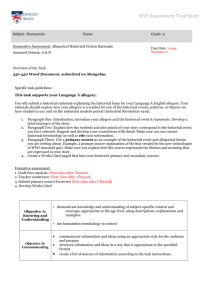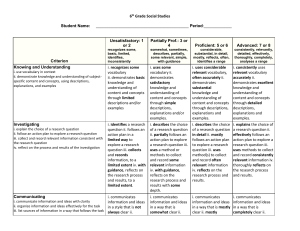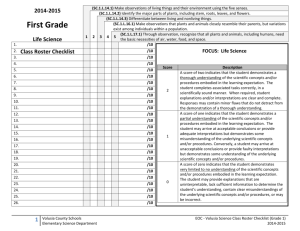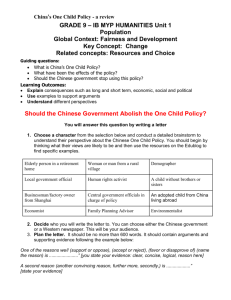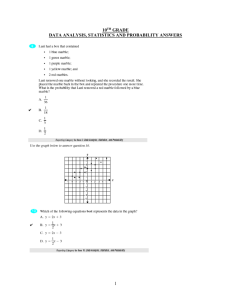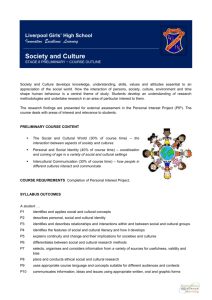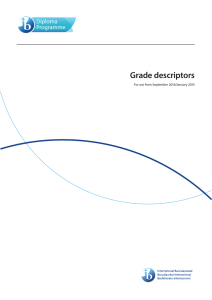LEAP Day 2013 Sample Assessment Criteria
advertisement
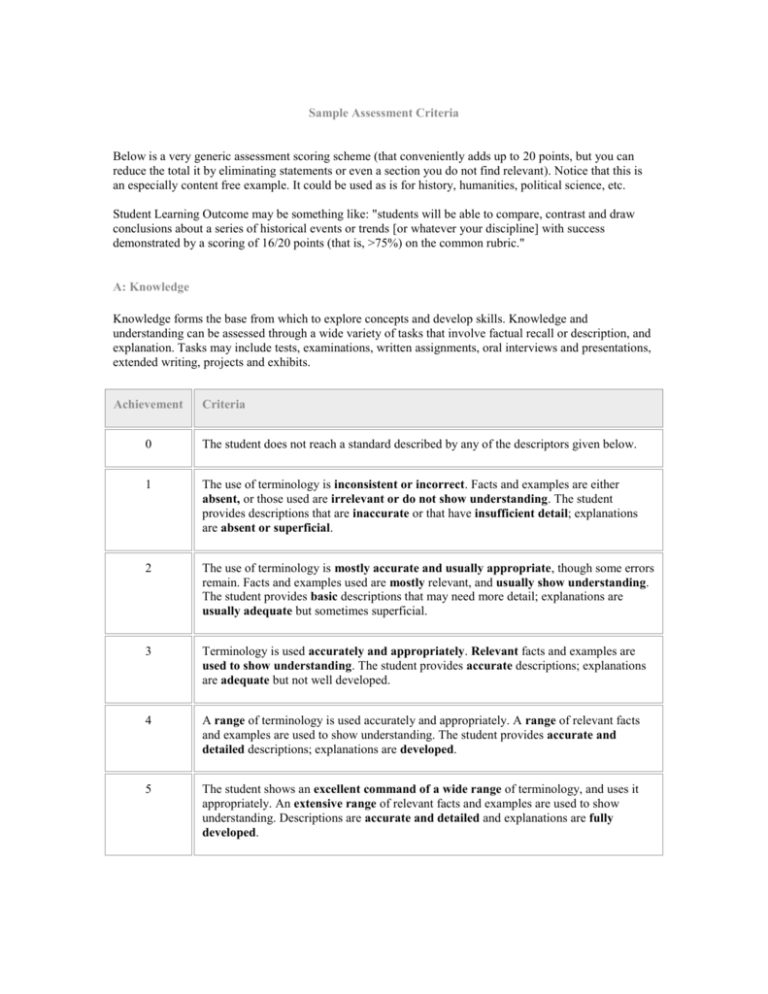
Sample Assessment Criteria Below is a very generic assessment scoring scheme (that conveniently adds up to 20 points, but you can reduce the total it by eliminating statements or even a section you do not find relevant). Notice that this is an especially content free example. It could be used as is for history, humanities, political science, etc. Student Learning Outcome may be something like: "students will be able to compare, contrast and draw conclusions about a series of historical events or trends [or whatever your discipline] with success demonstrated by a scoring of 16/20 points (that is, >75%) on the common rubric." A: Knowledge Knowledge forms the base from which to explore concepts and develop skills. Knowledge and understanding can be assessed through a wide variety of tasks that involve factual recall or description, and explanation. Tasks may include tests, examinations, written assignments, oral interviews and presentations, extended writing, projects and exhibits. Achievement Criteria 0 The student does not reach a standard described by any of the descriptors given below. 1 The use of terminology is inconsistent or incorrect. Facts and examples are either absent, or those used are irrelevant or do not show understanding. The student provides descriptions that are inaccurate or that have insufficient detail; explanations are absent or superficial. 2 The use of terminology is mostly accurate and usually appropriate, though some errors remain. Facts and examples used are mostly relevant, and usually show understanding. The student provides basic descriptions that may need more detail; explanations are usually adequate but sometimes superficial. 3 Terminology is used accurately and appropriately. Relevant facts and examples are used to show understanding. The student provides accurate descriptions; explanations are adequate but not well developed. 4 A range of terminology is used accurately and appropriately. A range of relevant facts and examples are used to show understanding. The student provides accurate and detailed descriptions; explanations are developed. 5 The student shows an excellent command of a wide range of terminology, and uses it appropriately. An extensive range of relevant facts and examples are used to show understanding. Descriptions are accurate and detailed and explanations are fully developed. B: Concepts Students must explore and re-explore key concepts in order to develop understanding. Students develop their understanding of a concept to increasing levels of sophistication by applying acquired knowledge and skills. Assessment tasks should allow students to demonstrate and apply the full extent of their understanding of the concepts specified within, or across, disciplines. It is not intended that any one piece of work will assess all of the concepts. Suggested tasks for assessment include extended writing, oral presentations, research projects, case studies, essays and tests. Whatever tool is chosen, it must give students the opportunity to demonstrate the requirements of the highest level criteria. Achievement Criteria 0 The student does not reach a standard described by any of the descriptors given below. 1 Application of concepts is inappropriate. The student may demonstrate some conceptual awareness and understanding by recognizing basic connections to the subject matter. 2 Application of concepts is not always appropriate. The student demonstrates conceptual awareness and understanding by describing basic connections to the subject matter. 3 Application of concepts is appropriate but superficial. The student demonstrates conceptual awareness and understanding by describing connections to the subject matter. The student attempts to apply concepts to other situations but is not always successful. 4 Application of concepts is appropriate and shows some depth. The student demonstrates conceptual awareness and understanding by explaining connections to the subject matter. The student applies concepts to other situations. 5 Application of concepts is appropriate and sophisticated. The student demonstrates conceptual awareness and understanding by explaining in detail connections to the subject matter. The student applies concepts effectively to other situations. C: Skills The development of skills is critical in enabling the student to undertake research and demonstrate an understanding of knowledge and concepts. Developments in the student’s technical, analytical, decisionmaking and investigative skills will be invaluable in transferring these skills to other subjects, and for lifelong learning. Assessment tasks may give the student the opportunity to demonstrate one or more of the skills described in the objectives. Tasks for assessment may include fieldwork, data analysis, artifact or image analysis, evaluation of sources and/or evidence, a research paper or similar piece of extended writing, case studies, and oral presentations/interviews. Achievement Criteria 0 The student does not reach a standard described by any of the descriptors given below. 1 The student can select and use some relevant information. The student displays minimal analytical skills. The student’s arguments, decisions or judgments are not always relevant, or may be absent. The student attempts to carry out investigations, demonstrating few skills. 2 The student selects and uses mostly relevant information. The student’s work lacks the required depth in analysis. The student makes some relevant arguments, decisions or judgments though these are unsupported. The student demonstrates basic investigative skills. 3 The student selects and uses relevant information. Work shows satisfactory evidence of analysis. Arguments, decisions and judgments are supported and balanced but superficial. The student demonstrates adequate investigative skills. 4 The student selects and uses a range of relevant information. Work shows a good level of critical analysis. Arguments, decisions and judgments are well supported and balanced. The student demonstrates effective investigative skills. 5 The student selects and uses a wide range of relevant information. Work shows a high level of critical analysis. Arguments, decisions and judgments are fully supported and well balanced. The student demonstrates sophisticated investigative skills. D: Organization and Communication Students need to develop the ability to organize and present information and ideas in order to be able to demonstrate their grasp of knowledge, concepts and skills. Note: This area is more suited to assessing extended pieces of work, for example, fieldwork, research projects or essays. Teachers should use only the relevant elements of the descriptors when assessing organization and presentation. Achievement Criteria 0 The student does not reach a standard described by any of the descriptors given below. 1 The student communicates information that may not always be relevant. The student attempts to structure the work, but it may be unclear and/or inappropriate to the format required. Presentation and expression are unclear and imprecise. There may be some evidence of documentation. 2 The student communicates information that is occasionally relevant. The student attempts to structure and sequence the work but is not always successful. Presentation and expression are occasionally unclear. Sources of information are documented, though there may be omissions or consistent errors in adhering to conventions. 3 The student communicates information that is mostly relevant. The student uses a structure appropriate to the task and sequences the content logically. Presentation and expression are clear; attention is paid to the audience and purpose in terms of appropriate language, style and visual representation. Sources of information are documented, with occasional errors in adhering to conventions. 4 The student communicates information that is always relevant. The student organizes information into a well-developed and logical sequence, appropriate to the format required. Presentation and expression are clear, concise and effective, and the language, style and visual representation used are always appropriate to the audience and purpose. All sources of information are documented according to a recognized convention. 5 The student selects and communicates a wide range of relevant information. Language and logical connection shows a high level of critical analysis. Arguments, decisions and judgments are clearly and fully stated, fully supported and well balanced. The student demonstrates sophisticated language skills.
